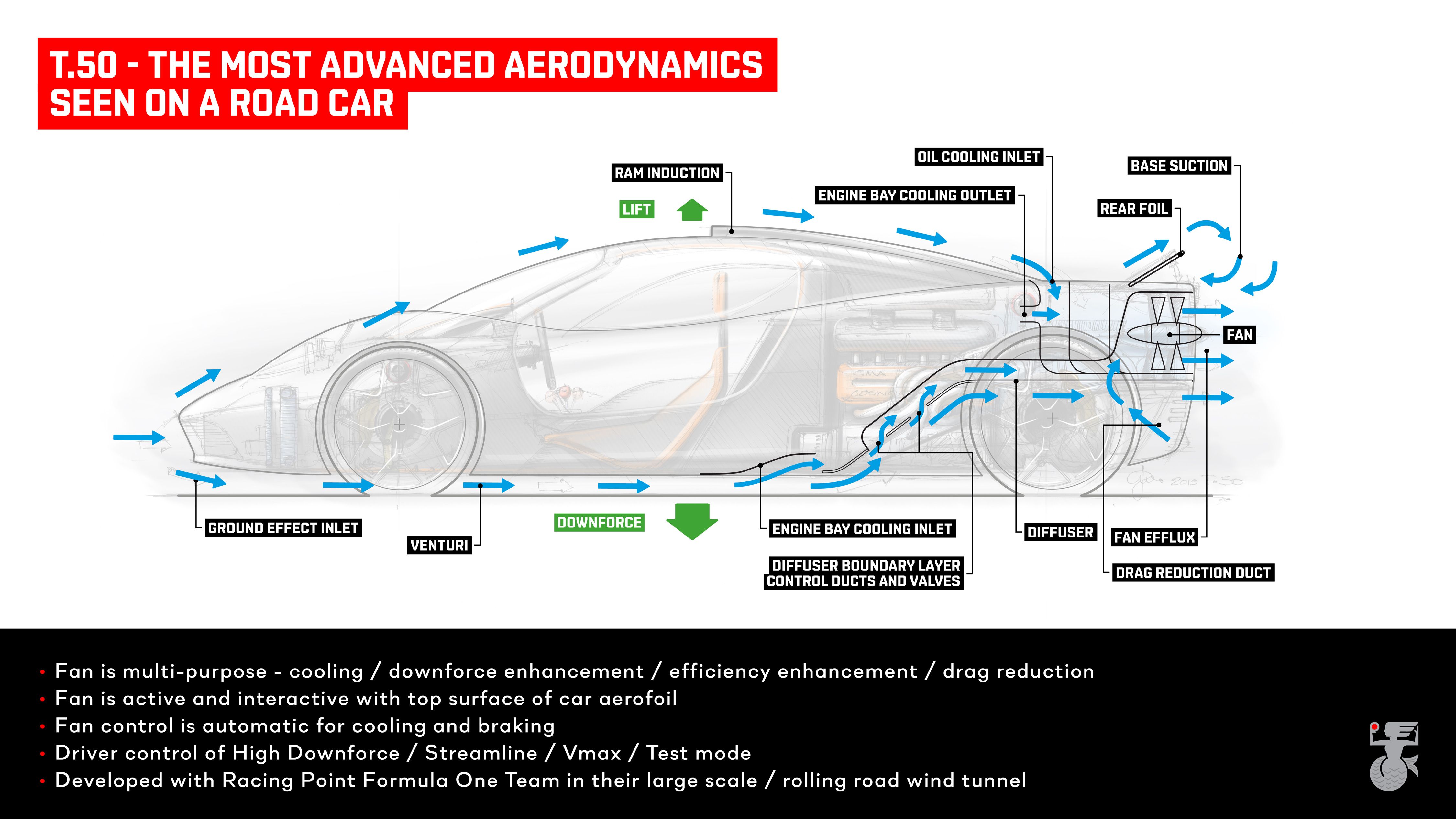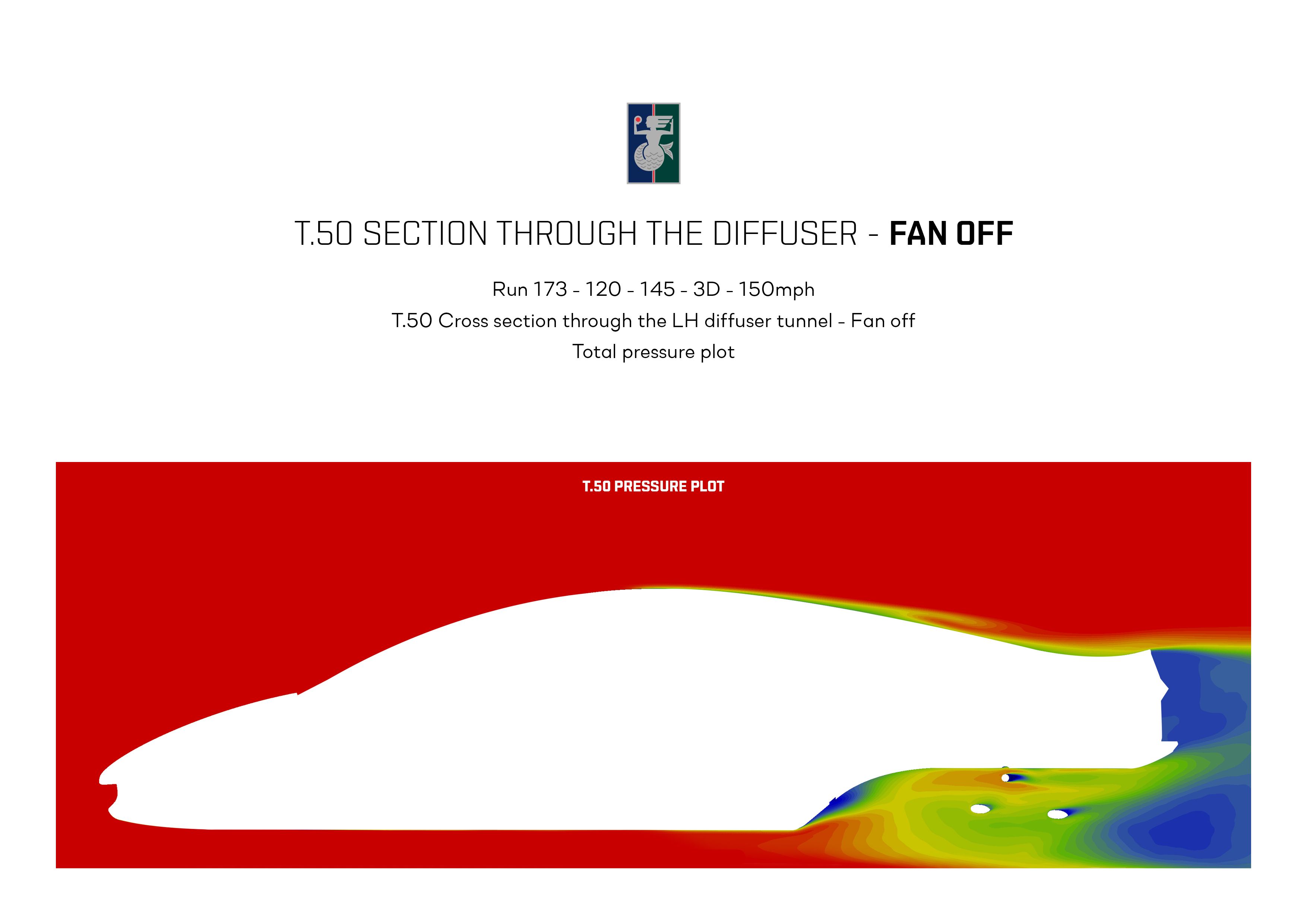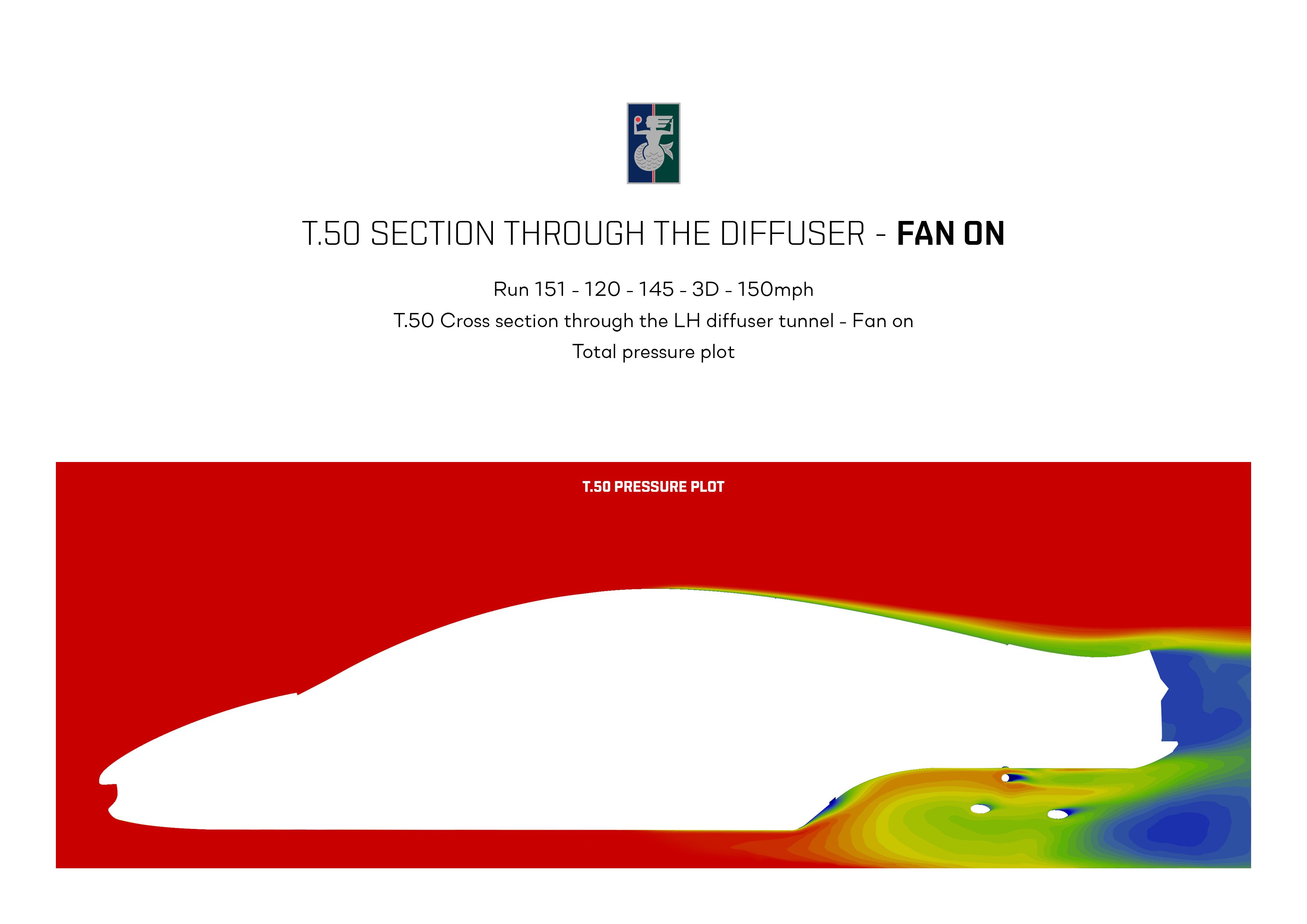Twenty-five years after helping launch the McLaren F1 supercar, auto design legend Gordon Murray is hard at work on finally launching the F1’s spiritual successor, the T.50 .
Though not officially a McLaren model, the T.50 traces its roots to the F1, in part because of Murray’s involvement in designing both cars. Consider the T.50, then, like a modern-day version of the F1, complete with the delta-formation, three-seater layout and an outrageous amount of cutting-edge aerodynamic technology that’s never before seen in a production car.
The T.50 is not just about big swoops, ducts, and a lot of the unsightly aero devices that have become common characteristics among a lot of today’s supercars. It eschews all of that in favor of a proprietary aerodynamic fan that’s located in the rear section of the Murray-penned supercar. The extent of the fan system’s importance in the T.50 has reached a point of partnership between Murray and his team and the Racing Point Formula One 1 team.
The Gordon Murray T.50 Aerodynamic Design
The T.50 is described as the most aerodynamic road car in history, and while it’s easy to chalk that up to Gordon Murray’s reputation as one of the best auto designers in the world, there’s a lot more to it than that. A lot more.
In the case of the T.50, the fan manages the airflow above and beneath the car, sucking the car down the road and pushing pressurized air out the back to help reduce drag. The fan works in concert with vertical ducts to pull air from under the car, creating a vacuum underneath that accomplishes the objective of keeping the car on the road.
"As designers and aerodynamicists, we'd all love to have very steep, aggressive diffusers at the back of the car to expand the air, and therefore, accelerate the air underneath and get more ground effect," Murray explained to Road & Track. "Unfortunately, air has a mind of its own, and it'll only follow a certain profile before it stalls and breaks away from the surface and causes a vortex or a series of vortices."
"We've done the ideal, very steep, aggressive, diffuser... We have strategically placed slots on that surface," he added. "What we do when the fan fires up, and we want more downforce at lower speeds, is we open the slots and spool the fan up to maximum, and we remove all the dirty air and the boundary layer, and that means that the air has to follow the surface. It's forced to follow the surface to fill the vacuum that was left there."
The result of this setup is the potential for the T.50 to create massive amounts of downforce at speeds that traditional aero devices like rear wings and spoilers are not able to provide.
Gordon Murray Automotive T.50 exterior dimensions
|
Length |
4,349 mm (171.22 inches) |
|---|---|
|
Width |
1,850 mm (72.83 inches) |
|
Height |
1,152 mm (45.35 inches) |
|
Wheelbase |
2,700 mm (106.3 inches) |
|
Front track |
1,586 mm (62.44 inches) |
|
Rear track |
1,525 mm (60.04 inches) |
|
Weight |
980 kg (2,160 pounds) |
|
Chassis / Body |
Full carbon fibre pre-preg monocoque, carbon fibre body |
The Gordon Murray T.50 Will Be Tested in an F1 Wind Tunnel
Developing that kind of technology is no small feat, especially for an automaker with the limited resources of Gordon Murray Automotive. That’s why partnerships and collaborations are important for the automaker. One such partnership GMA has is with the Racing Point Formula 1 team, specifically the use of the latter’s rolling road wind tunnel systems to help in the development of the T.50’s fan.
Having access to one of the world’s most advanced wind tunnels is a huge coup for GMA, especially in the development of a fan system that requires massive amounts of simulated airflow to help tweak and tune the T.50’s insane aerodynamic setup, which by the way, comes in six different modes.
The six aerodynamic modes are as follows:
-* Automatic Mode — The car’s default mode. Adjusts fan speed and the two flaps on either side of the fan in real-time.
-* Braking Mode — Deploys the rear aerofoils and uses the fan to increase downforce. This happens simultaneously at high-speed, doubling the level of downforce in the process. Stopping distances from 150 mph, as per Gordon Murray, are 33 feet shorter in this mode.
-* High-Downforce Mode (driver selected) — Increases downforce by 30 percent and improves the amount of traction the T.50 generates.
-* Streamline Mode (driver selected) — Reduces drag by 10 percent through the closing of the underbody ducts and spinning the fan up to high speeds. This mode creates what Murray describes as a “virtual long tail,” the same aerodynamic qualities that are created by the McLaren Speedtail. This mode also boosts the car’s straight-line speed.
-* V-Max Mode (driver selected) — Combines Streamline Mode with a 30-horsepower boost from the car’s 48-volt integrated starter-generator. The power boost lasts for three minutes.
-* Test Mode (driver selected) — Demonstrates the capabilities of the system when the car is at a standstill to ensure that everything is working properly.
The Gordon Murray T.50 Will Pump Out up to 700 Horsepower Thanks to That Weird Fan
It’s not the most powerful car on the road, but the engine redlines at 12,100 rpm, which means that it’s capable of burning more air and fuel to produce more power than most engines you’ll see on the market. That’s about 1,000 rpm higher than the Formula One-derived 1.6-liter turbocharged V-6 engine that powers the Mercedes-AMG Project One.
The V-12’s absurdly high max rpm ties into the functions of the proprietary fan system, specifically as it relates to the 30-horsepower boost from the 48-volt integrated starter-generator that you can tap into through the V-Max and Streamline aerodynamic modes. The latter, in particular, closes the underbody ducts and spins the fan up at high speeds, reducing drag by 10 percent in the process. This feature is also available in the V-Max mode, which comes with the added benefit of tapping into the aforementioned generator to produce 30 horsepower to the engine’s crankshaft for a maximum of three minutes before the battery runs out.
Gordon Murray Automotive T.50 specifications
|
Engine Type / number: |
Cosworth GMA |
|---|---|
|
Configuration: |
V12 semi-structural |
|
V. angle: |
65° |
|
Displacement: |
3,994 cc |
|
Valvetrain: |
Double overhead camshafts / variable valve timing / 4 valves per cylinder |
|
Lubrication system: |
Dry sump |
|
Maximum power: |
650 horsepower |
|
Maximum torque: |
332 pound-feet of torque |
|
Maximum rpm: |
12,100 rpm |
|
Starter: |
48-volt integrated starter |
|
Alternator: |
48-volt ISG (integrated starter-generator) |
|
Transmission Configuration: |
Transverse all synchro constant mesh |
|
Speeds: |
6 forward and reverse |
|
Gear selection: |
Manual with reverse lockout |
|
Suspension Front: |
Double wishbone with anti-roll bar |
|
Rear: |
Double wishbone – included axis GSP system |
|
Steering: |
TypeRack and pinion with LSPA |
What We Know About the Gordon Murray T.50's Performance and Specs
Gordon Murray didn’t dive into the T.50’s performance capabilities, but based on all the developments surrounding the supercar, we can all be confident that the T.50 will have incredible performance characteristics.
Advanced aerodynamics typically translates to impressive performance qualities so what does it say about the T.50’s unique setup that makes you doubt its ability to go fast? Combine all of that with the model’s carbon fiber body and full carbon fiber pre-preg monocoque chassis — it weighs only 980 kilos (2,160 pounds) — and you have a supercar that’s built and developed with full-blown performance in mind. As far as educated guesses go, it wouldn't be surprising to see the T.50, with its advanced aero, accelerate from 0 to 60 mph in less than three seconds on its way to a top speed approaching 200 mph.
Final Thoughts
There’s always a sense of trepidation when it comes to judging most automotive startups. As highly regarded as Gordon Murray is in the industry, it’s no different with his new company. That said, Murray has the kind of equity in the business that few people have. If there’s an automotive startup that can succeed in today’s industry, it’s the one that has his name attached to it. So far, the development of the T.50 has gone about as smooth as Murray could’ve hoped. Of the 100 models that GMA plans to build, most have already been claimed. And that’s considering that the T.50 costs over £2 million, or about $2.6 million based on current exchange rates. Murray says that a few build slots are still open, though based on the new revelations surrounding the T.50, I don’t expect those slots to remain open for long.
As for the T.50, there’s nothing much to say about it other than what’s already been said. If it does make it to production, the T.50 could rewrite the way supercars are built, at least as far as the focus on aerodynamics is concerned. It could be game-changing in ways nobody expected. Then again, this is Gordon Murray we’re talking about. He’s a legend in the business for a reason. Deliveries of the GMA T.50 are expected to begin sometime in January 2022.




